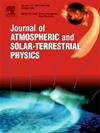Modeling of Zenith Tropospheric Delay using ERA5 data over East African region
IF 1.8
4区 地球科学
Q3 GEOCHEMISTRY & GEOPHYSICS
Journal of Atmospheric and Solar-Terrestrial Physics
Pub Date : 2024-12-01
DOI:10.1016/j.jastp.2024.106390
引用次数: 0
Abstract
The Zenith Tropospheric Delay (ZTD) is a crucial parameter in meteorology and climate research, often estimated from surface meteorological parameters and Global Navigation Satellite Systems (GNSS) observations. In East Africa, the lack of reliable surface meteorological data and gaps in GNSS observations compromise the accuracy and reliability of ZTD data. To address this issue, site-specific ZTD models were developed using ERA5 data from 2013 to 2017, employing Empirical Orthogonal Function (EOF) analysis. The accuracy of the proposed EOF models was validated using the tropospheric product from the Nevada Geodetic Laboratory (NGL) as a reference and compared to the Global Pressure and Temperature 3 (GPT3) ZTD model. The results of the study show that the EOF ZTD models significantly outperformed the GPT3 model, reducing Mean bias (MnB) by 72.3% and Root Mean Square Error (RMSE) by 3.0%. EOF models performed particularly well for stations near the equator (latitudes 4°S and 4°N) and between latitudes 12° S and 4° S in terms of MnB and RMSE, respectively. Seasonally, EOF models surpassed the GPT3 model in MnB and RMSE across most seasons near the equator, except during the September–October–November (SON) period, where GPT3 showed an 85.5% better performance in MnB. For stations between latitudes 12° S and 4° S, GPT3 generally performed better in terms of RMSE, except during the March–April–May (MAM) period, where the EOF model excelled. However, the EOF model consistently showed better (reduced) MnB in this region. This study demonstrates that the EOF method is a viable alternative for estimating ZTD in areas with limited surface meteorological data and GNSS observation gaps. The site-specific ZTD models developed using the EOF method can significantly improve the accuracy and reliability of ZTD data, with broad applications in geodesy, atmospheric science, and navigation among others.
利用ERA5数据模拟东非地区天顶对流层延迟
天顶对流层延迟(ZTD)是气象和气候研究中的一个重要参数,通常通过地面气象参数和全球导航卫星系统(GNSS)观测来估计。在东非,缺乏可靠的地面气象数据和GNSS观测的空白影响了ZTD数据的准确性和可靠性。为了解决这一问题,利用2013 - 2017年的ERA5数据,采用经验正交函数(EOF)分析,建立了特定站点的ZTD模型。利用内华达州大地测量实验室(NGL)的对流层产品作为参考,并与全球压力和温度3 (GPT3) ZTD模型进行了比较,验证了EOF模型的准确性。研究结果表明,EOF ZTD模型显著优于GPT3模型,平均偏差(MnB)降低72.3%,均方根误差(RMSE)降低3.0%。就MnB和RMSE而言,EOF模式在赤道附近(纬度4°S和4°N)和纬度12°S和4°S之间的站点分别表现得特别好。除9 - 10 - 11月(SON)季节外,赤道附近大部分季节EOF模式的MnB和RMSE均优于GPT3模式,GPT3模式在MnB上的表现优于GPT3模式85.5%。对于纬度12°S ~ 4°S之间的站点,除3 - 4 - 5月(MAM)期间EOF模式表现较好外,GPT3模式的RMSE总体表现较好。然而,EOF模型在该区域一致显示出更好(降低)的MnB。研究表明,在地面气象数据有限、GNSS观测空白的地区,EOF方法是估算ZTD的可行方法。利用EOF方法建立的特定站点ZTD模型可以显著提高ZTD数据的精度和可靠性,在大地测量学、大气科学和导航等领域具有广泛的应用前景。
本文章由计算机程序翻译,如有差异,请以英文原文为准。
求助全文
约1分钟内获得全文
求助全文
来源期刊

Journal of Atmospheric and Solar-Terrestrial Physics
地学-地球化学与地球物理
CiteScore
4.10
自引率
5.30%
发文量
95
审稿时长
6 months
期刊介绍:
The Journal of Atmospheric and Solar-Terrestrial Physics (JASTP) is an international journal concerned with the inter-disciplinary science of the Earth''s atmospheric and space environment, especially the highly varied and highly variable physical phenomena that occur in this natural laboratory and the processes that couple them.
The journal covers the physical processes operating in the troposphere, stratosphere, mesosphere, thermosphere, ionosphere, magnetosphere, the Sun, interplanetary medium, and heliosphere. Phenomena occurring in other "spheres", solar influences on climate, and supporting laboratory measurements are also considered. The journal deals especially with the coupling between the different regions.
Solar flares, coronal mass ejections, and other energetic events on the Sun create interesting and important perturbations in the near-Earth space environment. The physics of such "space weather" is central to the Journal of Atmospheric and Solar-Terrestrial Physics and the journal welcomes papers that lead in the direction of a predictive understanding of the coupled system. Regarding the upper atmosphere, the subjects of aeronomy, geomagnetism and geoelectricity, auroral phenomena, radio wave propagation, and plasma instabilities, are examples within the broad field of solar-terrestrial physics which emphasise the energy exchange between the solar wind, the magnetospheric and ionospheric plasmas, and the neutral gas. In the lower atmosphere, topics covered range from mesoscale to global scale dynamics, to atmospheric electricity, lightning and its effects, and to anthropogenic changes.
 求助内容:
求助内容: 应助结果提醒方式:
应助结果提醒方式:


